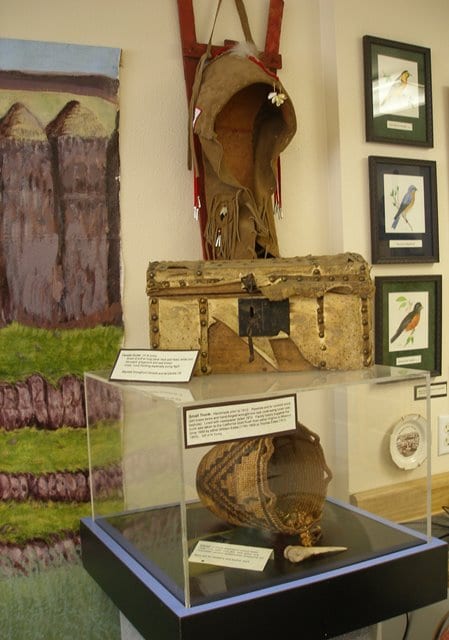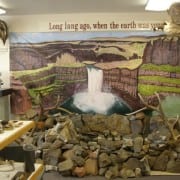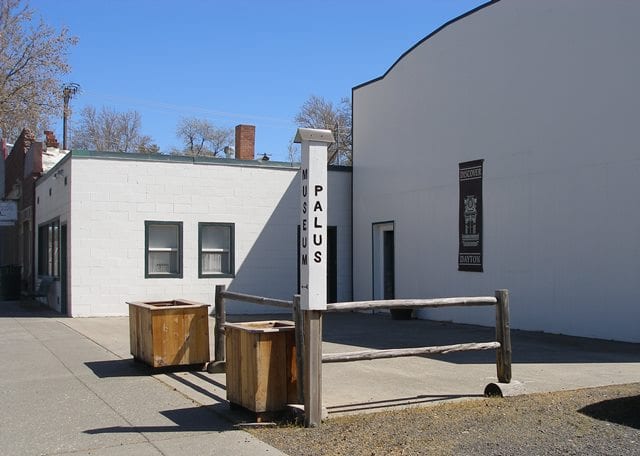Honoring an Ingenious People – The Palus Museum Celebrates the Heritage of the Palouse Indians

A large painting of Palouse Falls, surrounded by displays of artifacts, greets visitors as the enter the Palus Museum
We live in an area rich with history, steeped with the life stories of brave, hardworking people.
Frequently, those of us who reside in the West now associate those brave, hardworking people with the pioneers, many of whom did not make it here without losing someone along the way. But history goes back further than that, and before there were pioneers, there were brave, hardworking people who eventually lost a way of life: the Cayuse, the Nez Perce, the Umatilla, and the Palouse.
It is for this reason — that life changes, and we do not want to obscure or forget the past, and we wish to bring honor to those who live in the present — that a group of local people in Dayton joined together to create the Blue Mountain Heritage Society in 1999, with a focal interest to engage the public in the rich and diverse regional history of Columbia County and its environs. And one of principal people in this rich history are the Palouse Indians.
A small tribe in Southeastern Washington and Northern Idaho that was culturally related to the Nez Perce, the Palouse (or Palus) “were a very smart people and a very strong people,” according to Rose Engelbrite, one of the founding members of the society and the manager of the Palus Museum in Dayton.
“The things they had to make and do just in order to survive were very involved, from making shoes and arrowheads to gathering food.”

A hand woven basket, a baby carrier, and a trunk dating from 1812 are a link to the past at the Palus Museum.
The museum, which possesses an unpretentious exterior that belies the treasures within, is home to numerous and diverse artifacts, from beadwork to handspun rope, bone hairpieces, clothing, hand crafted tools, a medicine bag, and — the foundation upon which the collection was started — arrowheads gleaned from the area by local resident Wayne Casseday.
“Collecting artifacts was a hobby of his, and he wanted other people to see them,” Engelbrite explains. “He asked us if we would be interested to set up a place where these could be shown and not be stored away out of sight.”
The arrowheads are all colors and sizes, painstakingly and skillfully crafted for their specific purpose, testament to the artistry and personality of their makers. One of Engelbrites favorite artifacts, however, looks like a long, slim rock, about the size of a small foot, and slightly curved, just like a foot. This is no accident, she says, but further evidence of the Palouse Indians’ astute resourcefulness.
“It’s a last,” she explains, “which is an object that shoemakers build their shoes around. Back then (the 1800s, and earlier) many shoes did not have a right shoe and a left shoe, but it was the same shape for both feet.
“The Palouse Indians used this last which has a light curve at the top, so they were able to make one shoe, a right one, and then flip over the last and make a left one.
“As I say, they were an ingenious people.”
The Palouse were noted horse breeders and traders — the Appaloosa, with its distinctive spotted coat, drawing its name from that of the tribe. Numbering around 1,600 during the expedition of Lewis and Clark, the Palouse tribe migrated between Palouse Falls in the winter, where the fishing was plenty, to the Dayton area in the summer, where they collected berries.
But as we know, with the advent of explorers, trappers, and pioneers from the east, this way of life drastically changed, and two cultures clashed until the Palouse, dwindling in size, no longer roamed the land they once lived. The museum itself addresses the issue, with exhibits featuring relics from both the Lewis and Clark Expedition and the pioneering homesteaders.
Set next to a woven cooking basket made from cedar root and cedar root skin is a small, handmade trunk, consisting of rawhide and fur over wood and lined with newspaper dated 1812. An annex to the museum houses the homestead room, with butter churns, washboards, a cast iron wood stove and an impressive display of the many styles of barbed wire used for fencing.
Most of the historical items are local, donated by families of the area, interested in the historical society’s mission and eager to contribute so that the past, though it is in the past, will have its place in the present.
“This is the history of the area in which we live,” Engelbrite says, “and it is a part of all our heritage.”
 The Palus Museum, at 426 E. Main, is located two blocks from Wenaha Gallery in Dayton, WA, and is well worth a visit to view. Admission to the museum is free, with donations gratefully accepted. The museum is open Fridays and Saturday from 1 to 4 p.m. For more information, contact Rose at 509.337.8875, or contact the historical society through its Facebook Page.
The Palus Museum, at 426 E. Main, is located two blocks from Wenaha Gallery in Dayton, WA, and is well worth a visit to view. Admission to the museum is free, with donations gratefully accepted. The museum is open Fridays and Saturday from 1 to 4 p.m. For more information, contact Rose at 509.337.8875, or contact the historical society through its Facebook Page.
Contact the gallery by phone at 800.755.2124 or e-mail art@wenaha.com. Gallery hours are 9 a.m. to 6 p.m. from Monday through Saturday, and by appointment. Visit the Wenaha Gallery website online at www.wenaha.com.
Wenaha Gallery is your destination location for Greenwich Workshop Fine Art Prints, professional customized framing, and original fine art paintings and sculpture by notable Pacific Northwest artists. Books, gifts, note cards, jigsaw puzzles, and more are also available. Visit at 219 East Main, Dayton, WA.
This article was written by Carolyn Henderson.





